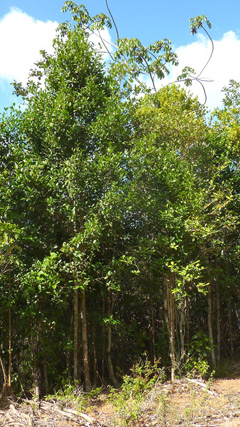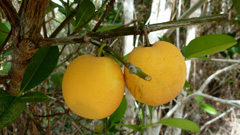 |
|
Alex Popovkin wikimedia.org |
 |
| Alex Popovkin wikimedia.org |
Translate this page:
Summary
A small evergreen tree with a dense crown. A popular fruit within its native range, being gathered from the wild and also commonly cultivated in home gardens.
Physical Characteristics

 Garcinia gardneriana is an evergreen Tree growing to 8 m (26ft) by 6 m (19ft) at a slow rate.
Garcinia gardneriana is an evergreen Tree growing to 8 m (26ft) by 6 m (19ft) at a slow rate.
See above for USDA hardiness. It is hardy to UK zone 10.
Suitable for: light (sandy), medium (loamy) and heavy (clay) soils. Suitable pH: mildly acid, neutral and basic (mildly alkaline) soils. It can grow in semi-shade (light woodland) or no shade. It prefers moist soil.
UK Hardiness Map
US Hardiness Map
Synonyms
Possibly a a synonym of Garcinia brasiliensis Mart.(also in the database).
Plant Habitats
Edible Uses
Edible Parts: Fruit
Edible Uses:
Fruit - raw[416 ]. An acidic, pulpy flesh[416 ]. A sweet, white pulp[419 ]. A very tasty fruit but it has little edible pulp[419 ]. The fruit is around 5cm in diameter[416 ].
References More on Edible Uses
Medicinal Uses
Plants For A Future can not take any responsibility for any adverse effects from the use of plants. Always seek advice from a professional before using a plant medicinally.
None known
References More on Medicinal Uses
The Bookshop: Edible Plant Books
Our Latest books on Perennial Plants For Food Forests and Permaculture Gardens in paperback or digital formats.

Edible Tropical Plants
Food Forest Plants for Hotter Conditions: 250+ Plants For Tropical Food Forests & Permaculture Gardens.
More

Edible Temperate Plants
Plants for Your Food Forest: 500 Plants for Temperate Food Forests & Permaculture Gardens.
More

More Books
PFAF have eight books available in paperback and digital formats. Browse the shop for more information.
Shop Now
Other Uses
Fencing Furniture Wood
Other Uses: The wood is soft, moderately heavy, moderately durable under natural conditions[419 ]. It is used for the manufacture of tool handles, fence posts, general construction etc[419 ]. We do not have any more information on the wood of this species, but a general description of the wood for trees in the Americas which were formerly considered to be in the genus Rheedia is as follows:- The heartwood is dark yellow-brown, grayish- or pinkish-brown, merging gradually into the sapwood; surfaces are sometimes specked with resinous exudations. The texture is medium to coarse; the grain straight to irregular and roey; luster medium to rather low; it is free from discernible odour or taste. Species in Surinam are rated durable to attack by decay fungi and fairly resistant to dry wood termites. Species in Colombia are resistant to a brown-rot fungus but not the white-rot in a laboratory assay. Under field conditions the wood was susceptible to decay and attack by insects. It dries rapidly, but is reported to be moderately difficult to air season, tending to warp and check. Reports on workability vary with species from moderate to high resistance to cutting to machining fairly well; reports on ease of finishing are also variable. The wood is used for purposes such as furniture, flooring (quarter sawn), heavy construction, and general carpentry[316 ].
Special Uses
Food Forest
References More on Other Uses
Cultivation details
Although in nature the tree grows in the shade of the rainforest, it produces more fruit when growing in a sunny position[419 ]. Trees can withstand periodic inundation[419 ]. Newly planted young trees are slow to establish and grow away[419 ]. Young trees, planted in a sunny position, commence fruiting sooner than plants growing in shady positions[419 ].
References Carbon Farming Information and Carbon Sequestration Information
Temperature Converter
Type a value in the Celsius field to convert the value to Fahrenheit:
Fahrenheit:
The PFAF Bookshop
Plants For A Future have a number of books available in paperback and digital form. Book titles include Edible Plants, Edible Perennials, Edible Trees,Edible Shrubs, Woodland Gardening, and Temperate Food Forest Plants. Our new book is Food Forest Plants For Hotter Conditions (Tropical and Sub-Tropical).
Shop Now
Plant Propagation
Seed - best sown as soon as it is ripe, in a shady position in individual containers. A germination rate in excess of 80% is usually achieved with the seed sprouting in 60 - 80 days. The seedlings grow away slowly[419 ].
Other Names
If available other names are mentioned here
achacha, achachairú - Spanish (Bolivia)
Native Range
SOUTHERN AMERICA: Brazil, Amazonas, Bahia, Ceará, Mato Grosso, Minas Gerais, Pará, Paraná, Rio de Janeiro, Rio Grande do Sul, Santa Catarina, São Paulo, Amapá, Bolivia, Cochabamba, El Beni, La Paz, Santa Cruz, Paraguay,
Weed Potential
Right plant wrong place. We are currently updating this section.
Please note that a plant may be invasive in one area but may not in your area so it's worth checking.
Conservation Status
IUCN Red List of Threatened Plants Status : This taxon has not yet been assessed

Growth: S = slow M = medium F = fast. Soil: L = light (sandy) M = medium H = heavy (clay). pH: A = acid N = neutral B = basic (alkaline). Shade: F = full shade S = semi-shade N = no shade. Moisture: D = dry M = Moist We = wet Wa = water.
Now available:
Food Forest Plants for Mediterranean Conditions
350+ Perennial Plants For Mediterranean and Drier Food Forests and Permaculture Gardens.
[Paperback and eBook]
This is the third in Plants For A Future's series of plant guides for food forests tailored to
specific climate zones. Following volumes on temperate and tropical ecosystems, this book focuses
on species suited to Mediterranean conditions—regions with hot, dry summers and cool, wet winters,
often facing the added challenge of climate change.
Read More
Expert comment
Author
(Planch. & Triana) Zappi
Botanical References
1
Links / References
For a list of references used on this page please go here
A special thanks to Ken Fern for some of the information used on this page.
Readers comment
| Add a comment |
|
If you have important information about this plant that may help other users please add a comment or link below. Only comments or links that are felt to be directly relevant to a plant will be included. If you think a comment/link or information contained on this page is inaccurate or misleading we would welcome your feedback at [email protected]. If you have questions about a plant please use the Forum on this website as we do not have the resources to answer questions ourselves.
* Please note: the comments by website users are not necessarily those held by PFAF and may give misleading or inaccurate information.
To leave a comment please Register or login here All comments need to be approved so will not appear immediately.
|
Subject : Garcinia gardneriana
|
|
|
|